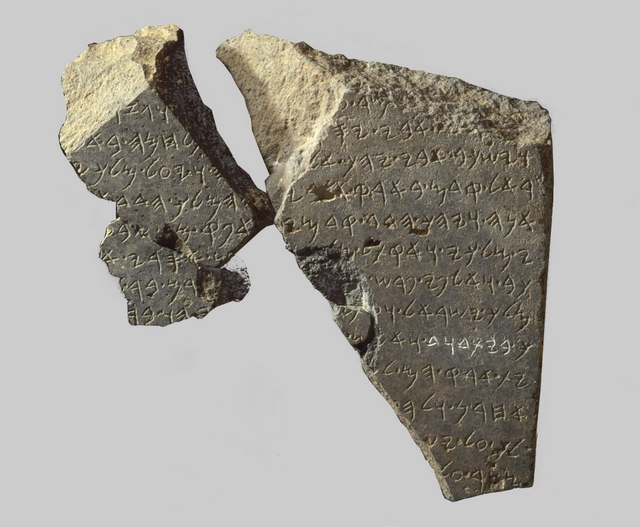Tel Dan Stele, c. 840 BCE
“[I killed Jeho]ram son of [Ahab] King of Israel… And [I] slew [the king] of the house of David”
Date- c. 840 BCE
Current Location- Skirball Museum, Jerusalem, Israel
Language and Script- Aramaic; alphabetic
General Information-
The Tel Dan Stele was erected by an Aramaic king in the mid-9th century BCE. Ancient Aram was to the northeast of Israel, in present day Syria. The inscription on the basalt stele, written in Old Aramaic, describes his accession to the throne and his victory over the king of Israel and over “the House of David.” The stele was broken in antiquity; only three fragments have been discovered to date, preserving about 13 lines of text. These pieces were reused as building materials in buildings dating to the mid-8th century BCE, but the writing on the stones is dated through paleography to the mid-9th century BCE. Although the Aramaic king’s name is not found in the surviving text, the most likely candidate is Hazael of Damascus, whose rivalry with Israel is recorded in the Bible (2 Kings 8-7–15).

Israel Musem / Israel Antiquities Authority, photo by Ardon Bar-Hama
Relevance to Ancient Israel-
• The most notable feature of the inscription is the use of the expression “House of David” (Hebrew, byt dwd) in line 9, making it the earliest known extra-Biblical mention of David and the dynasty he founded. This is crucial for corroborating the Biblical account, since many scholars have at least minimized the importance of the actual David, if not relegated him to fictional myth. The expression “House of David” is used repeatedly in the Bible for the Davidic Dynasty (for example, 1 Kings 12-19, 13-2; Isaiah 7-2; Psalm 122-5). It reigned over all Israel in the period of the United Monarchy (10th century BCE) and over Judah during the Divided Monarchy until the capture of Jerusalem by the Babylonians in 586 BCE.
• The identification of the Aramaic king who authored the stele as Hazael fits well with the Bible’s account (2 Kings 10-32–33; 13-3, 22; Amos 1-3–4) of his frequent attacks on Israel.
Circumstances of Discovery and Acquisition- Archaeologists under the direction of Avraham Biran had been excavating at Tel Dan, in northern Israel, for more than 20 years when the first fragment of the inscribed basalt stele, also the largest of the three discovered to date, was discovered in 1993. It was uncovered during a restoration project of the ancient gateway at Tel Dan that year sitting on the surface by the side of the path toward the gate! In the following year, two additional, smaller pieces of the inscription were found.
David Danzig
See also-
- For a personal account of the discovery of the Tel Dan Stele- How I Discovered the “House of David” Inscription, Gila Cook, COJS.
- The Remarkable Discoveries at Tel Dan, John C. H. Laughlin, BAR 7-05, Sep-Oct 1981.
- BAR Interview- Avraham Biran—Twenty Years of Digging at Tel Dan, Hershel Shanks, BAR 13-04, Jul-Aug 1987.
- Prize Find- Tel Dan Scepter Head, Avraham Biran, BAR 15-01, Jan-Feb 1989.
- “David” Found at Dan, BAR 20-02, Mar-Apr 1994.
- Sacred Spaces, Avraham Biran, BAR 24-05, Sep-Oct 1998.
- Biran at Ninety, Hershel Shanks, BAR 25-05, Sep-Oct 1999.
- Tel Dan Excavations
- Jerusalem Post- Long live the House of David!
- Tel Dan Stele – Evidence of King David? (video)
- King David, 1005-965 BCE
What do you want to know?
Ask our AI widget and get answers from this website